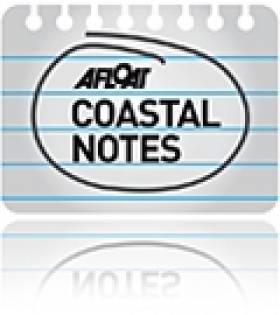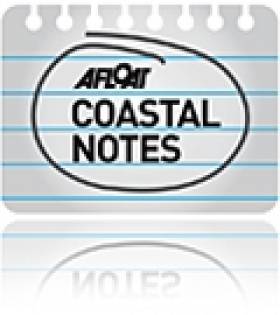Displaying items by tag: flooding
Cork In Recovery After Flood Waters Reach 'Waist Height'
#Flood - Just days after Limerick experienced its worst flooding in recent memory, Cork city last night was deluged by a high tide that saw waters reportedly rise to waist height on lower lying streets.
As RTÉ News reports, Cork Lord Mayor Catherine Clancy has called for the speeding-up of plans for new flood defences following what she described as a "red-alert" situation for the city, the centre of which lies on an island surrounded by the River Lee.
Businesses and residents in the city centre were this morning in recovery mode after two nights of flooding that have caused thousands of euro worth of damage, according to The Irish Times, though council-issued gel bags helped avoid an even worse disaster.
Clare County Council Undertake Emergency Flood Defence Works
Clare County Council is to commence emergency flood defence works along the County Clare coastline near Quilty over fears that up to 15 homes could experience flooding.
Recent storms caused significant coastal erosion at Cloughaninchy leaving private residential properties exposed to flooding by sea water.
The local authority is investing 50,000 euro, which it says it will seek to recoup from any future funding allocation from Government, to install approximately one thousand 1-tonne bags of rock and sand as an interim flood defence barrier.
Cloughaninchy is already the subject of a funding application submitted to Government by Clare County Council. The local authority is seeking €2,581,250 to undertake permanent coastal protection works over a 800 metre stretch of coastline as well as repairs to a road, sewage pumping station and bridge, all damaged by recent flooding.
Mayor of Clare Cllr. Joe Arkins commented: "In recent days Clare County Council has met with residents at Cloughaninchy to discuss ways of addressing the very real threat of flooding posed to a number of residential properties. I want to praise the Chairman of the residents group, Michael Neenan for his pragmatic approach and to acknowledge the support of my fellow elected members in ensuring these works will now proceed."
Clare County Manager, Tom Coughlan says he has informed the Department of the Environment of the local authority's plans to proceed with emergency flood defence works.
In a letter to Sean Hogan, who is National Director for Fire and Emergency Management at the Department of the Environment, Mr. Coughlan stated: "The Council has undertaken a survey of the levels of coastline and it appears that the level of the high tides which are due in early February may exceed the height of the shoreline which has been reduced as a consequence of the storms. Such an occurrence, without the benefit of interim defence works, would probably result in flooding of private residential properties which have already suffered flooding earlier this month."
He continued: "The only apparent possible defence to this undesirable flooding event is the construction of coastal protection over a length of approximately 800 metres. It is not possible, for a number of reasons, to construct a permanent protection of rock armour at this time. However, in order to attempt to provide an interim defence, Clare County Council is proceeding with the construction of a temporary barrier of bags of material and other works along the shoreline. This temporary barrier will be constructed on the private properties along the shore and an agreement has been entered into between the landowners and the Council to facilitate the necessary works."
"Clare County Council has not made financial provision for this emergency work which may cost in excess of €50,000 – however, we have no option but to make every effort to safeguard the properties at Cloughaninchy," concluded Mr. Coughlan
Flooding Will Happen 'With Or Without' Galway Port Expansion
#Flooding - Flooding events in Galway of the likes experienced in the recent winter storms will occur more regularly "with or without" the expansion of the city's port, according to Galway's harbourmaster.
As The Irish Times reports, Capt Brian Sheridan said "worst case scenario" modelling has been carried out on the masterplan for the port's expansion, which was lodged with An Bórd Pleanála yesterday (10 January).
Proposals for the scheme, which would see 27 hectares of land reclaimed from Galway Bay, include a "mini Sydney Opera House".
But for now, many residents in Galway and other western coastal areas blighted by the recent extreme weather are concentrating on picking up the pieces.
On Achill Island, guesthouse and gallery owner John Bartlett said the tight-knit community was "pretty well whacked" by the tidal flooding and sea surges that wreaked havoc along the Mayo coast.
And further south in Kerry, fisherman Patrick O'Sullivan tells The Irish Times of the shocking night last week when the Atlantic literally crashed into his young family's home.
Storm Surges Send Seasiders Fleeing In Lahinch As Flooding Continues
#Flooding - Seaside residents in the popular surfing spot of Lahinch in Co Clare were evacuated yesterday (3 January) after massive swells driven by strong storm-force winds encroached half a kilometre inland.
According to The Irish Times, the emergency came amid some of the worst weather ever experienced in the West Clare coastal town.
Aside from flooding homes throughout the town, the storm surges collapsed metal fencing on the shorefront and sent concrete wall cappings some 50 metres across the promenade car park.
Nearby, part of the old pier in Liscannor were destroyed by the violent wind and wave action, while the 150-year-old base of the Irish Coast Guard's Doolin unit was also damaged, with the road leading from the base to the pier broken up.
Elsewhere in the country, records were broken in Dublin as the River Liffey saw its highest ever tide, breaking its banks near Heuston Station yesterday afternoon.
The Irish Independent reports that Wolfe Tone Quay and Victoria Quay were closed for an hour while Dublin City Council workers pumped the floodwaters from the roads.
In the coastal suburb of Clontarf - the worst-hit area of the capital, experiencing its worst flooding in a decade - seafront businesses were spared when floodwaters stopped just metres from their doors.
Meanwhile, Galway and Cork remain on high alert as high tide brings floodwaters to city streets, with the Salthill Promenade still a no-go area.
#MARINE NOTICE - The latest Marine Notice from the Department of Transport, Tourism and Sport (DTTAS) draws mariners' attention to the official report on the sinking of the fishing boat Ainmire and its recommendations for safety on board all fishing vessels.
As reported in September last year on Afloat.ie, the report by the Marine Casualty Investigation Board found that a breach in the engine compartment caused the Ainmire to take on water and sink off the coast of Scotland in April 2011.
The report concluded that the failure of a sea water cooling pipe in the engine room was the most likely cause of the flooding, and noted that the pipework had not been renewed during the life of the vessel.
Investigators also noted that the bilge pump was located under the floor plates in the engine room as was this inoperable when the water level rose in the compartment.
Marine Notice No 58 of 2012 - a PDF of which is available to read and download HERE - reminds fishing vessel operators that large sea-water inlets in engine rooms make their boats vulnerable to severe flooding if they fail.
It is recommended that these pipes should be checked for corrosion every year, especially around the welded joint at the hull. Ultrasonic thickness testing of the pipework should also be considered.
Moreover, such pipework can be eroded quickly by stray currents, so electrical equipment should be checked regularly, while the location of bilge pumps in the engine room should be carefully considered
Galway Councillors Put Shannon Flooding Decision On Hold
#SHANNON FLOODING - Galway Bay FM reports that Galway county councillors have postponed making any decision on an Oireachtas report into flooding in areas adjacent to the River Shannon.
The move was taken on the suggestion of Cllr Dermot Connolly in the wake of a joint Dáil and Seanad committee report that highlights eight proposals for dealing with flooding issues along the longest of Ireland's inland waterways.
Cllr Michael Connolly has suggested that Minister for the Environment Phil Hogan and Minister for the Gaeltacht Jimmy Deenihan should meet to discuss the report's findings from both a flooding and environmental stance.
Meanwhile, the Irish Independent reports that the Office of Public Works (OPW) has agreed to carry out tests at Meelick weir on the Shannon in Co Offaly after thousands of acres of farmland were flooded over the summer, ruining silage crops and summer grazing land.
Waterways Ireland has denied allegations that a failure to open sluices and lift boards at the weird contributed to the flooding.
Irish Sea Level to Rise Almost 50cm by 2099
#COASTAL NOTES - It's an alarming figure by any means - new research shows that the level of the Irish Sea will rise by almost half a metre by the end of the century, leading to much more severe flooding along the east coast and elsewhere.
The results of research published by the Ryan Institute at NUI Galway, as reported by The Irish Times, show that sea level rises of up to 47cm are not out of the question.
They also indicate that sea surface temperatures will increase by nearly 2 degrees, which would have serious implications for marine wildlife and the fishing industry.
Dr Mike Hartnett of the Tyan Institute said the new research - from 3D model-based projections of the seas around Ireland - is the most comprehensive study of its kind, and confirms previous "tentative" studies in the area.
The news comes after national weather forecaster Met Éireann announced an incredible 0.75 degree rise in average temperature in Ireland - and a 5% increase in rainfall - over the past two decades alone.
And with recent flooding in Cork and Belfast causing millions of euro worth of damage, the real implications of such figures is coming closer to home.
The Irish Times has more on the story HERE.
#FLOODING - The clean-up has begun across Cork city and county after heavy flooding over the past two days resulted in millions of euro worth of damage, as The Irish Times reports.
Debris blocking a rubbish screen on a new culvert on the Douglas river has been blamed for the more than four feet of flood water that swamped the suburb of Douglas south of Cork city.
Elsewhere in the city, six people were evacuated from homes in the Meadow Brook Estate in Glanmire after the Glashaboy river burst its banks.
RTÉ News - which has a photo gallery of affected areas in and around Cork - reports that electricity is being restored to most customers after widespread power outages.
Met Éireann's Eoin Sherlock said that nearly 50mm of rain fell in a single six-hour period on Wednesday night - more than two-thirds of the monthly average rainfall for June.
Meanwhile, in Belfast politicians face public anger over flash flooding overwhelmed the city and left major routes impassable and sparked concerns over rising sewage water.
According to the Irish Independent, Northern Ireland emergency services reported more than 700 call-outs linked to the flooding in greater Belfast alone.
Minister for Regional Development Danny Kennedy, who is responsible for the North's roads and water system, said that "no infrastructure would have been able to cope with the level of rainfall that we have seen.
"It simply isn't designed to cope with those volumes of rain."
Gale, Flood Warning In Effect for Ireland Today
#WEATHER - Met Éireann is warning that more gale force winds will affect many parts of Ireland and the Irish Sea today (28 December).
According to the forecaster, stormy conditions over Connacht, Ulster and parts of north Leinster will see gale force westerly winds with gusts of between 100 and 130 km/h.
The worst winds are expected in exposed coastal and hilly areas of Ulster and Connacht. There is also an increased risk of flooding as a result of high astronomical tides combined with very high seas.
Shannon Sluice Gates Opened to Allay Flood Concerns
#INLAND WATERWAYS - Sluice gates have been opened at locks and dams along the River Shannon due to flooding concerns, The Irish Times reports.
The ESB confirmed that water levels in the upper Shannon had been rising significantly since September, and were just below those recorded prior to the flooding in Carrick-on-Shannon two years ago.
However the flooding threat has abated this week, with levels in Lough Allen dropping by around 300cm, although the situation is still subject to amounts of rainfall in the coming days as the Shannon drains slowly.
Levels in Lough Ree have also stabilised after rising throughout October.
The ESB continues to discharge from the Ardnacrusha power plant, while Waterways Ireland has commenced dredging at Meelick in Co Galway.
The Irish Times has more on the story HERE.






































































